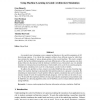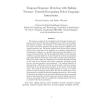725 search results - page 96 / 145 » Learning Behaviors Models for Robot Execution Control |
JMLR
2006
13 years 8 months ago
2006
An essential step in designing a new computer architecture is the careful examination of different design options. It is critical that computer architects have efficient means by ...
ICRA
2005
IEEE
14 years 2 months ago
2005
IEEE
— We consider the problem of inferring sensor positions and a topological (i.e. qualitative) map of an environment given a set of cameras with non-overlapping fields of view. In...
GECCO
2007
Springer
14 years 17 days ago
2007
Springer
A primary goal of evolutionary robotics is to create systems that are as robust and adaptive as the human body. Moving toward this goal often involves training control systems tha...
CONNECTION
2006
13 years 8 months ago
2006
We present an approach for recognition and clustering of spatio temporal patterns based on networks of spiking neurons with active dendrites and dynamic synapses. We introduce a n...
NN
2002
Springer
13 years 8 months ago
2002
Springer
This paper presents a biologically-inspired, hardware-realisable spiking neuron model, which we call the Temporal Noisy-Leaky Integrator (TNLI). The dynamic applications of the mo...


